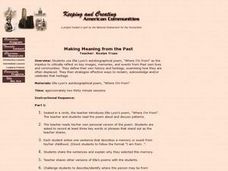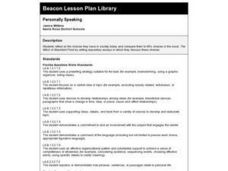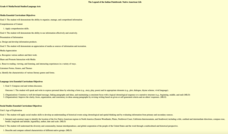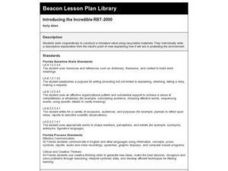Curated OER
A Photo Essay
Students explain the purpose of a photo essay, sequence a series of events, and explain the format in creating a photo essay, which includes a caption for each picture. They complete a photo essay as a creative activity.
Curated OER
Historical Figures
Student research a "Historical Individual" using the Internet. They print a minimum of five articles and organize them. They create a visual biography of their historical figure.
Pennsylvania Department of Education
The Letter B (b)
Students discover words through text, audio and images that begin with the letter B. In this letter B lesson, students download an ebook and navigate through an interactive reading activity.
Curated OER
Making Meaning from the Past
Young scholars read Ella Lyon's autobiographical poem, "Where I'm From" as the impetus to critically reflect on key images, memories, and events from their own lives and communities.
Curated OER
Memories, A Connection to the Past
Third graders read four books related to the past and memories. With a partner, they complete a graphic organizer for each story in English or Spanish. To end the lesson plan, they write a short paper summarizing the material and...
Curated OER
The Legend of Sleepy Hollow
Students research the American Revolution through the story of the Legend of Sleepy Hollow. In this American Revolution lesson, students research folktale and The Legend of Sleepy Hollow. Students view illustrations for the story....
Curated OER
All's Well That Ends Well
Students examine and discuss the parts of a speech and how to organize them. They read sample speeches, then write a short presentation to read to the class, identifying the beginning, middle, and ending of their speech.
Curated OER
Historical Fiction - Based on facts or purely fiction?
Young scholars, after reading an Accelerated Reader historical fiction book, research the actual historical time period portrayed in the book. Then, working in a cooperative learning group, they create a HyperStudio presentation.
Curated OER
How Do I Get There From Here?
Sixth graders use a school map to create a charted course and a corresponding written description of the directions for travel from class to class, beginning with an arrival location in the morning and ending with a departure location in...
Curated OER
The Study of the Spanish-Speaking People of Texas: Understanding Primary Sources
Students analyze Russell Lee's photo essay as a sign of segregation in Texas. They consider the differences between primary and secondary sources and how historians use these sources.
Curated OER
Who Plays What?
Ninth graders divide in pairs 3 cards with the words possible, impossible and certain on them. Ask questions of the class and get the students to hold up the word that describes the event (for example) Tomorrow it will snow. You have...
Curated OER
Recovering Under-examined Histories to Build Community
Young scholars read Diane Glancy's "Pushing the Bear" about the Cherokee Removal and respond online to a discussion board. They discuss responses in class.
Curated OER
Hickory Dickory Dock Webquest
Pupils listen to and read nursery rhymes. They discuss rhyming words. Students play a variety of computer games with rhymes, numbers and telling time. They retell the story through dramatic play, speech, and comprehension questions.
Curated OER
Personally Speaking
Seventh graders read, "The Witch of Blackbird Pond," and write an expository essay discussing choices they have in society today compared with the character Kit.
Curated OER
The Legend of the Indian Paintbrush: Native American Life
Pupils read," The Legend of the Indian Paintbrush" by Tomie dePaola and discuss the way legends are passed down orally. They then create their own legend and illustrate it on a simulated "Buffalo Skin" made from brown paper.
Curated OER
Second Graders Create Their Own Social Studies Book (Part I, The 5Ws of the Constitution)
Students study the United States Constitution and create a year-long cumulative activity for social studies. In this social studies lesson, students complete activities throughout the year to learn the 5Ws for the United States...
Curated OER
Stretch to the Math Tables
Students count by multiples while performing stretches or exercises. They listen to music and skip count by a given multiple. The rhythm of the music as well as the repitition assists them in their memorization of multiplication facts.
Curated OER
Introducing the Incredible RBT-2000
Fourth graders construct a miniature robot using recyclable materials. They write a descriptive explanation from the robot's point of view explaining how it aid in protecting the environment.
Curated OER
A Funny Happened on the Way to Monticello
Third graders examine the Journey of Lewis and Clark and how it relates to Thomas Jefferson and Monticello. They read about, discuss and complete worksheet pertaining to the Lewis and Clark expedition.
Curated OER
Why Walk?
First graders listen to the book Yummers. They use the food pyramid to evaluate what Emily Pig ate during her walk and find out why her walk made her sick. They participate in a walking game.
Curated OER
Reggae Music
In this music worksheet, students read an excerpt about Reggae music from Jamaica. They identify when and where it began and how the lyrics are sung. Students also respond to six questions related to reggae music.
Curated OER
Comprehension: Create a Summary from an Expository Text
Children can learn to analyze expository or informational texts at nearly any age. This scaffolded and scripted resource provides teachers with the support needed to facilitate a thoughtful lesson on summarizing informational text by...
Curated OER
Animal Diaries
Launch this lesson with Doreen Cronin's Diary of a Worm! Discuss the format and content of a diary, and ask learners if they've ever kept a diary before. Then, after an introductory discussion, have learners choose an insect or another...
ReadWriteThink
A Picture's Worth a Thousand Words: From Image to Detailed Narrative
A picture's worth a thousand words—and even more inspiration! A visual activity uses photographs to inspire writers. The process teaches aspects of narrative writing, such as point of view and characterization.

























